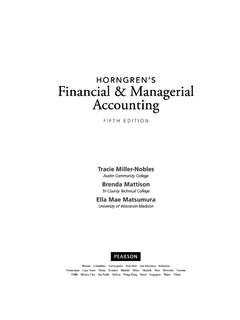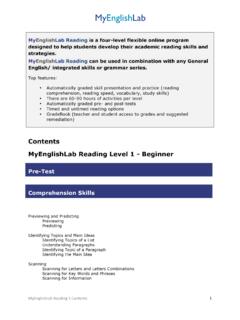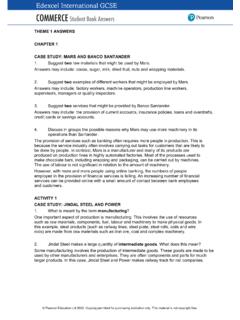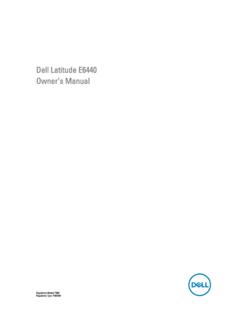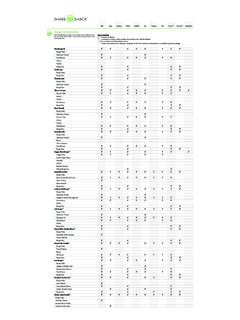Transcription of Musculoskeletal System - Pearson
1 834 Learning ObjectivesUpon completion of this chapter, you will be able to Identify and define the combining forms, prefixes, and suffixes introduced in this chapter. Correctly spell and pronounce medical terms and major anatomical structures relating to the Musculoskeletal System . Locate and describe the major organs of the Musculoskeletal System and their functions. Correctly place bones in either the axial or the appendicular skeleton. List and describe the components of a long bone. Identify bony projections and depressions. Identify the parts of a synovial joint. Describe the characteristics of the three types of muscle tissue. Use movement terminology correctly. Identify and define Musculoskeletal System anatomical terms. Identify and define selected Musculoskeletal System pathology terms. Identify and define selected Musculoskeletal System diagnostic procedures.
2 Identify and define selected Musculoskeletal System therapeutic procedures. Identify and define selected medications relating to the Musculoskeletal System . Define selected abbreviations associated with the Musculoskeletal 8318/12/14 10:12 pm84 FunctionThe skeletal System consists of 206 bones that make up the internal framework of the body, called the skeleton. The skeleton supports the body, protects internal organs, serves as a point of attachment for skeletal muscles for body movement, produces blood cells, and stores are the primary structures that comprise the skeletal System :bones jointsWord PartsHere are the most common word parts (with their meanings) used to build skeletal System terms. For a more comprehensive list, refer to the Terminology section of this FormsSection I: Skeletal System at a Glanceankyl/ostiff jointarthr/ojointarticul/ojointburs/osac carp/owristcervic/oneckchondr/ocartilage clavicul/oclaviclecoccyg/ococcyxcortic/o outer layercost/oribcrani/oskullfemor/ofemurfi bul/ofibulahumer/ohumerusili/oiliumischi /oischiumkyph/ohumplamin/olamina (part of vertebra)lord/obent backwardlumb/oloin (low back between ribs and pelvis)mandibul/omandiblemaxill/omaxilla medull/oinner regionmetacarp/ometacarpalsmetatars/omet atarsalsmyel/obone marrow, spinal cordorth/ostraightoste/obonepector/oches tpatell/opatellaped/ochild; footpelv/opelvisphalang/ophalangespod/of ootprosthet/oadditionpub/opubisradi/orad ius.
3 Ray (X-ray)sacr/osacrumscapul/oscapulascoli/ ocrookedspin/ospinespondyl/overtebraeste rn/osternumsynovi/osynovial membranesynov/osynovial membranetars/otarsus (ankle)thorac/ochesttibi/otibiauln/ 8418/12/14 10:12 pm85 Skeletal System Illustrated ScapulaHumerusUlnaRadiusSacrumCoccyxCarp alsMetacarpalsPhalangesIschium FemurPatellaSternumRibsThoracic vertebrae (T11)Lumbarvertebrae (L4)IliumPubisSkullCervical vertebraeMaxillaMandibleTibiaFibulaTa 8518/12/14 10:12 pm86 Chapter 4 Anatomy and Physiology of the Skeletal Systembone marrowbonesjointsligaments (LIG-ah-ments)skeletonEach bone in the human body is a unique organ that carries its own blood supply, nerves, and lymphatic vessels. When these bones are connected to each other it forms the framework of the body called a skeleton. The skeleton protects vital organs and stores minerals.
4 Bone marrow is the site of blood cell production. A joint is the place where two bones meet and are held together by ligaments. This gives flexibility to the skeleton. The skeleton, joints, and muscles work together to produce Term TipThe term skeleton, from the Greek word skeltos meaning dried up, was originally used in reference to a dried-up mummi-fied body, but over time came to be used for (CAR-tih-lij)osseous tissue (OSS-ee-us)ossification (oss-sih-fih-KAY-shun)osteoblasts (OSS-tee-oh-blasts)osteocytes (OSS-tee-oh-sights)Bones, also called osseous tissue, are one of the hardest materials in the body. Bones are formed from a gradual process beginning before birth called ossifi-cation. The first model of the skeleton, made of cartilage, is formed in the fetus. Osteoblasts, immature bone cells, gradually replace the cartilage with bone.
5 In a fully adult bone, the osteoblasts have matured into osteocytes that work to maintain the bone. The formation of strong bones is greatly dependent on an adequate supply of minerals such as calcium (Ca) and phosphorus (P).Bone StructureWhat s In A Name?Look for these word parts:oste/o = bone-blast = immature-cyte = cell-ous = pertaining toarticular cartilage (ar-TIK-yoo-lar)cancellous bone (CAN-sell-us)compact bonecortical bone (KOR-ti-kal)diaphysis (dye-AFF-ih-sis)epiphysis (eh-PIFF-ih-sis) flat bonesirregular boneslong bonesmedullary cavity (MED-you-lair-ee)periosteum (pair-ee-AH-stee-um)red bone marrowshort bonesspongy boneyellow bone marrowSuffixes-listhesisslipping-logicpe rtaining to study of-porosisporousPrefixesdis-apartnon-not -blastimmature-clasiato surgically break-desisto 8618/12/14 10:12 pmMusculoskeletal System 87 Figure Classification of bones by shape.
6 Irregular bones(vertebrae) flat bones(ribs)Long bone(humerus) flat bones(scapula)Short bones(tarsals)Bones have many projections and depressions; some are rounded and smooth in order to articulate with another bone in a joint. Others are rough to provide muscles with attachment points. The general term for any bony Med Term TipThe elbow, commonly referred to as the funny bone, is actually a projection of the ulna called the olecranon (KON-dile)epicondyle (ep-ih-KON-dile)fissure (FISH-er)foramen (for-AY-men)fossa (FOSS-ah)headneckprocesssinus (SIGH-nus)trochanter (tro-KAN-ter)tubercle (TOO-ber-kl)tuberosity (too-ber-OSS-ih-tee)Several different types of bones are found throughout the body and fall into four categories based on their shape: long bones, short bones, flat bones, and irregular bones (see Figure ).
7 Long bones are longer than they are wide; examples are the femur and humerus. Short bones are roughly as long as they are wide; examples are the carpals and tarsals. Irregular bones received their name because the shapes of the bones are very irregular; for example, the vertebrae are irregular bones. flat bones are usually plate-shaped bones such as the sternum, scapulae, and majority of bones in the human body are long bones. These bones have similar structure with a central shaft or diaphysis that widens at each end, which is called an epiphysis. Each epiphysis is covered by a layer of cartilage called articular cartilage to prevent bone from rubbing directly on bone. The remaining surface of each bone is covered with a thin connective tissue membrane called the periosteum, which contains numerous blood vessels, nerves, and lymphatic vessels.
8 The dense and hard exterior surface bone is called cortical or compact bone. Cancellous or spongy bone is found inside the bone. As its name indicates, spongy bone has spaces in it, giving it a spongelike appearance. These spaces contain red bone marrow, which manufactures most of the blood cells and is found in some parts of all center of the diaphysis contains an open canal called the medullary cavity. Early in life this cavity also contains red bone marrow, but as we age the red bone marrow of the medullary cavity gradually converts to yellow bone marrow, which consists primarily of fat cells. Figure contains an illustration of the structure of long Projections and DepressionsWhat s In A Name?Look for these word parts:articul/o = jointcortic/o = outer layermedull/o = inner regionoste/o = boneperi- = around-al = pertaining to-ar = pertaining to-ary = pertaining toMed Term TipDo not confuse a long bone with a large bone.
9 A long bone is not necessarily a large bone. The bones of your fingers are short in length, but since they are lon-ger than they are wide, they are classified as long Term TipThe term diaphysis comes from the Greek term meaning to grow between. 8718/12/14 10:12 pm88 Chapter 4 Figure Components of a long bone. The entire long bone is on the left side accompanied by a blow-up of the proximal epiphysis and a section of the cartilageEpiphyseal lineSpongy boneCompact boneMedullary cavityCompact (cortical) boneArticular cartilageCancellous (spongy) boneYellow marrow (fat)Compact bonePeriosteumArteriesaxial skeleton (AK-see-al)Axial SkeletonWhat s In A Name?Look for these word parts:-al = pertaining to-ar = pertaining toMed Term TipNewborn infants have about 300 bones at birth that will fuse into 206 bones as an is a process.
10 Then there are specific terms to describe the different shapes and locations of various processes. These terms are commonly used on operative reports and in physicians records for clear identification of areas on the individual bones. Some of the common bony processes include the following:1. The head is a large, smooth, ball-shaped end on a long bone. It may be sep-arated from the body or shaft of the bone by a narrow area called the A condyle refers to a smooth, rounded portion at the end of a The epicondyle is a projection located above or on a The trochanter refers to a large rough process for the attachment of a A tubercle is a small, rough process that provides the attachment for ten-dons and The tuberosity is a large, rough process that provides the attachment of ten-dons and Figure for an illustration of the processes found on the , bones have hollow regions or depressions, the most common of which are the:1.
